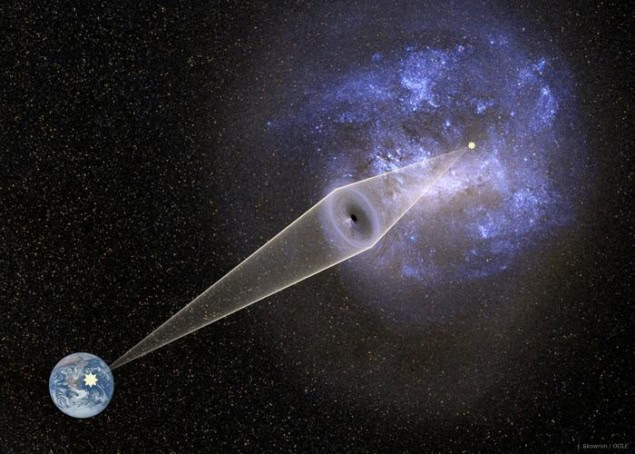
When the gravitational wave detectors LIGO and VIRGO observed signals from merging black holes with masses much higher than those of black holes that form from the collapse of stars, scientists were intrigued. Had these unusually massive black holes formed when the universe was very young? And might they contain large amounts of dark matter?
According to new analyses of 20 years of data from the Optical Gravitational Lensing Experiment (OGLE) survey, the answer to the second question is a firm “no”. At most, members of the survey say that these cosmological structures contain only few percent of the universe’s dark matter – the mysterious substance that emits no light and can only be detected thanks to its gravitational pull, but is nevertheless thought to make up 95% of all matter. Indeed, the survey results casts doubt on the very existence of early-origin black holes, sending researchers back to the drawing board for explanations.
A different origin for some black holes?
Since the first detection of gravitational waves from a pair of merging black holes in 2015, LIGO and VIRGO have spotted more than 90 such events. These black holes are 20 to 100 times more massive than our Sun, making them four to five times more massive than any black hole previously detected within our Milky Way galaxy.
One possible explanation for why the universe might contain different masses of black holes was put forward by the Soviet physicists Yakov Zeldovich and Igor Novikov in 1966, and independently by the British physicist Stephen Hawking in 1971. They proposed that some black holes could have formed in the very early universe, before the first stars appeared. The mechanisms that created these so-called “primordial” black holes would be different from those that produce black holes via stellar collapse, which would remove some constraints on their masses.
Gravitational microlensing
In the OGLE survey, a team led by Andrzej Udalski of the Astronomical Observatory of the University of Warsaw, Poland, analysed light from nearly 80 million stars in the Large Magellanic Cloud, a nearby satellite of our own Milky Way. Their goal was to find characteristic brightenings of stars due to an effect known as microlensing. This effect occurs when a massive object (either dark matter or normal matter) passes between an observer on Earth and a source of light in such a way that the three objects line up almost perfectly.
At that point, Udalski explains, Einstein’s general theory of relativity means the intermediate object “can act as a lens – it gravitationally bends the light so more rays arrive to the observer and the source star is brighter,” he says. “The changes of brightness are very characteristic and very rare, but they can be detected.”
The duration of this brightening depends on the mass of the lensing object: the heavier it is, the longer the event. Microlensing events involving solar-mass objects typically last several weeks, whereas those that feature black holes 100 more massive than the Sun would last a few years.
Only 13 events detected
Previous gravitational microlensing dark-matter surveys (including the US-led MACHO and French EROS as well as OGLE) indicated that black holes lighter than one solar mass comprise less than 10% of dark matter. However, these observations were not directly sensitive to extremely long-timescale microlensing events, so they were not sensitive to massive black holes like those recently observed via gravitational waves.
To address this gap, Udalski and colleagues re-analysed their data. If black holes of 10 solar masses made up all the dark matter in our cosmic neighbourhood, they calculated that OGLE should have detected 258 microlensing events. If dark matter was instead composed of 100- or 1000-solar-mass black holes, the survey should have yielded 99 or 27 microlensing events, respectively. “During the 20 years of our experiment we should have registered over 500 microlensing events,” Udalski tells Physics World. “In reality, however, we detected only 13.”
The explanation, he says, is simple: the dark matter in the galactic “halo” between the Milky Way and the Large Magellanic Cloud cannot contain the kind of primordial black holes that would cause microlensing events. “All of the 13 events we registered can be nicely explained as events caused by nearby galactic stars or stars in the Large Magellanic Cloud located somewhat in front of that galaxy,” Udalski says. “This indicates that massive black holes can compose at most a few percent of dark matter.”

Concerning primordial black holes
More specifically, the team’s calculations revealed that black holes of 10 solar masses may comprise at most 1.2% of dark matter. For 100-solar-mass black holes, the number increases to 3%; for 1000-solar-mass black holes, it is 11%.
An “important impact” on astrophysics and cosmology
Udalski thinks the team’s findings will have an “important impact” on astrophysics and cosmology. “The first conclusion is that there is no empirical proof that primordial black holes ever existed,” he explains. “Because it is supposed that they were formed in the very early universe, our picture of the beginnings must be revised. Secondly, as dark matter does not contain classical bodies that can cause microlensing events, it still remains a mystery what this matter is.”
While OGLE in its present form is nearly finished, the team still plan to investigate putative black holes with very low, planet-scale masses. “This will allow us to fully exploit the potential of the microlensing observations of the Large Magellanic Cloud,” Udalski says.
The study’s results are detailed in Astrophysical Journal Supplement Series and Nature.



